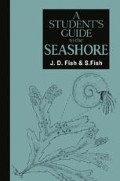Abstract
The nemerteans are elongate, often ribbon-like worms with bilateral symmetry. They are non-segmented and have a ciliated epidermis, but unlike the flatworms have a separate mouth and anus. Dorsal to the gut, and separate from it, is a muscular, eversible proboscis used in the capture of food and in defence. It is from this structure that the animals get one of their common names, the proboscis worms. They are also known as ribbon worms. Nemerteans are carnivorous and feed on a wide variety of crustaceans, polychaete worms and molluscs. Prey is captured by the proboscis, which in some species has a piercing stylet, and is usually ingested whole. They also scavenge on dead and decaying animals. Most nemerteans have separate sexes and fertilization is usually external. In some species the gametes are deposited in an egg sac where fertilization and development take place. Several different types of larvae have been described, including a ciliated pelagic larva known as a pilidium. Length of life is believed to be about one year but the larger species possibly live for several years.
Access this chapter
Tax calculation will be finalised at checkout
Purchases are for personal use only
Preview
Unable to display preview. Download preview PDF.
References
Cibson,R. 1982. British nemerteans. Keys and notes for the odentification of the species. Synopses of the British fauna (New Series), No. 24. Cambridge: Cambridge University Press.
McIntosh, W.C. 1873–4. A monngraph of the British annelids. Vol. I Part 1. The nemerteans. London: Ray Society.
Bartsch, I. 1973. Zur Nahrungsaufnahme von Tetrastemma melanocephalum (Nemertini). Helgoländer wissenschaftliche Meeresuntersuchungen 25 326–31.
Gibson, R. 1972. Nemerteans London: Hutchinson.
Riser, N.W. 1974. Nemertinea. In Reproduction of marine invertebrates Vol. 1. A.C. Giese & J.S. Pearse (eds), 359–89. New York: Academic Press.
Sundberg, P. 1984. Multivariate analysis of polymorphism in the hoplonemertean Oerstedia dorsalis (Abildgaard, 1806). Journal of Experimental Marine Biology and Ecology 78 1–22.
Author information
Authors and Affiliations
Rights and permissions
Copyright information
© 1989 J.D. Fish & S. Fish
About this chapter
Cite this chapter
Fish, J.D., Fish, S. (1989). Nemertea. In: A Student’s Guide to the Seashore. Springer, Dordrecht. https://doi.org/10.1007/978-94-011-5888-6_11
Download citation
DOI: https://doi.org/10.1007/978-94-011-5888-6_11
Publisher Name: Springer, Dordrecht
Print ISBN: 978-0-04-574044-4
Online ISBN: 978-94-011-5888-6
eBook Packages: Springer Book Archive

